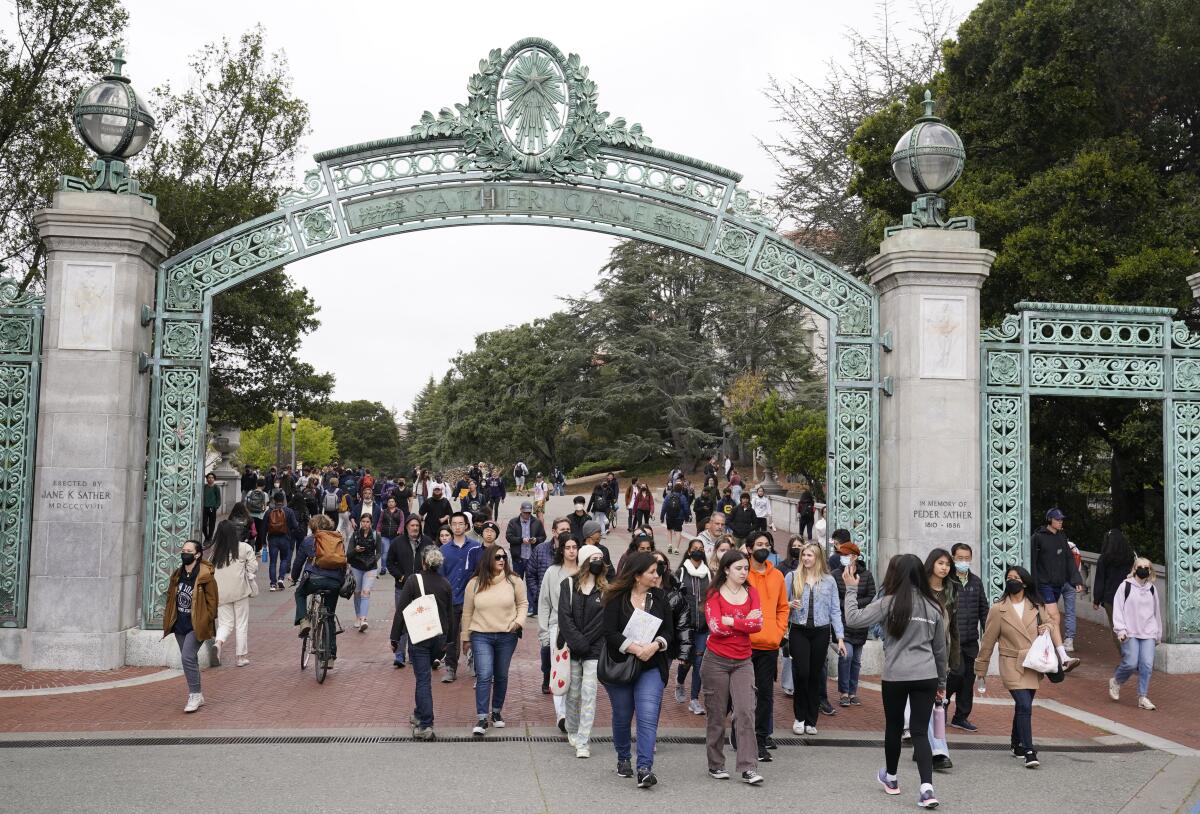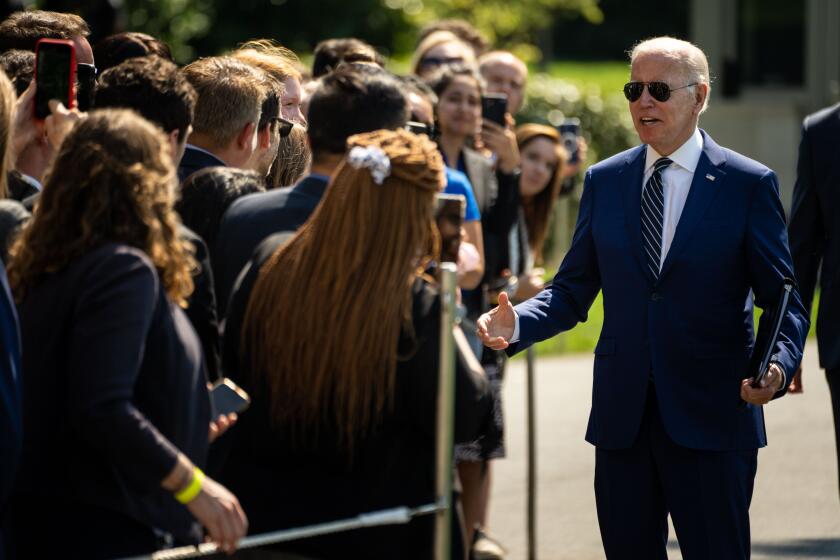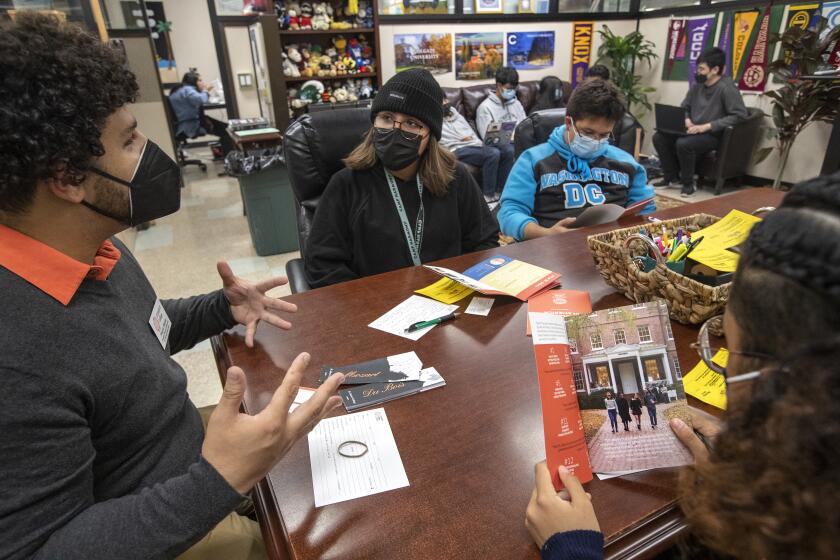Why Californians with student loans will gain massively from forgiveness plan

Sadia Khan, a recent graduate of UC Berkeley, was glued to her iPhone on Wednesday, refreshing Twitter and reading articles to gather emerging details of President Biden’s landmark student loan debt forgiveness plan.
When she learned she was eligible for up to $10,000 in loan forgiveness — enough to wipe out her entire $6,000 federal debt — the financially struggling single mother was overcome with relief.
“We’ve been pinching pennies on everything,” said Khan, 27, a legal studies major. “As someone who doesn’t have anybody to fall back on, this would be life-changing.”
Biden’s plan won’t go nearly as far to help Maria Williams, a 29-year-old assistant director at the University of Redlands. She will qualify for up to $20,000 in loan forgiveness because she received a federal Pell grant for low-income students when she attended Cal State San Bernardino, graduating in 2015. But that will cover less than one-third of her $73,000 in undergraduate and graduate debt, a burden so stressful she teared up talking about it.
“It’s a bittersweet feeling,” she said. “It gives you a little bit of relief, but there is still a ways to go. I still don’t see the finish line.”
Overall, the plan announced Wednesday would massively benefit California borrowers, who by their sheer numbers hold the nation’s largest share of the $1.6 trillion in federal loan debt owed by 43 million current and former college and trade school students across the country.
About 4 million Californians hold an average student loan debt of $37,783, according to the Federal Reserve Bank of New York.
But thanks to California’s generous financial aid programs and relatively low tuition at public colleges and universities, the average undergraduate loan debt is the third lowest in the nation after Utah and New Mexico, according to the Institute for College Access & Success.
About 46% of Californians had an average undergraduate student loan debt of $21,125 in 2019-20. That compares with $30,951 for 54% of New Yorkers with debt and $26,271 for 52% of Texans, the institute estimated.
About 92% of California borrowers will be eligible for the new loan forgiveness, according to Charlie Eaton, a UC Merced associate professor of sociology and student loan expert.
Under the plan, the federal government will forgive up to $10,000 for those who earn less than $125,000 annually and up to $20,000 for those who received a Pell Grant for low-income students. The Department of Education is proposing a rule to reduce the required minimum payment for undergraduate loans from 10% of disposable income to 5% for those in a particular repayment plan based on income. Under the proposal the borrower’s unpaid monthly interest would be covered.
The Biden administration’s student loan relief plan is expected to wipe out the debt of 1 million or more Californians. Here’s who is eligible and for how much forgiveness.
“This is a historic day,” Eaton said. “And it’s going to have major repercussions for our economy and a transformative impact on millions of student loan borrowers’ lives.”
Several studies showed that even pausing student loan payments during the pandemic — which Biden extended to Dec. 31 — allowed borrowers to save money, take more time to find better jobs, buy cars and even homes and start families, Eaton said. The loan forgiveness plan could amplify those benefits, giving a boon to younger generations who have acquired just one-seventh the household wealth that baby boomers had at the same stage in their lives in 1989, he said.
Advocates for college affordability touted the debt cancellation as a major step forward but say much more needs to be done so students can graduate without having to borrow money.
“We’ve been working on this issue for years, and so to get it at this level … it’s just amazing,” said Samantha Seng, the legislative director and policy advisor for NextGen Policy, a California-based nonprofit that advocates for progressive policies. “More reforms need to happen so that we can at least get folks on the pathway to debt-free college and hopefully free college one day.”
But Seng said the plans will do very little to eliminate racial wealth gaps for many borrowers and urged more changes to how students pay for college, including restructuring loan programs and the loan servicing industry.
In 2015-16, 21% of Black graduates with bachelor’s degrees accumulated more than $50,000 in student loan debt, compared with 10% for whites, 7% for Latinos and 6% for Asians, according to a California Student Aid Commission report. Black borrowers held an average of $52,726 in student loan debt after graduation — nearly 50% more than their white peers.
Manny Rodriguez, the director of policy and advocacy in California for the Institute for College Access & Success, an organization that pushes to make higher education more affordable, said the state must focus on driving down college costs for students. Oftentimes, students at California’s public colleges and universities borrow money to pay for nontuition expenses, such as housing, food and transportation.
California colleges used to be more affordable, Eaton said. Only 1 in 8 college students had any federal loans in the 1970s. But that began to change in the 1990s, when a recession hit, the state cut funding to higher education, tuition levels rose and the federal government expanded access to student loans. Another spike in student loan debt followed the 2008 recession, he said.
In recent years, however, California’s political and educational leaders have boosted the state’s financial aid programs — now the most generous in the nation. The Cal Grant program, for instance, now fully covers tuition for about 600,000 students and is set to expand to an additional 150,000 students in 2024 after Gov. Gavin Newsom and the Legislature widened eligibility by dropping age, time out of high school and other requirements.
Unlike student loans, grants do not have to be repaid — a fact that not all students understand, said Marlene Garcia, executive director of the California Student Aid Commission.
She said all high school students will be required to fill out the federal form required to access financial aid — known as the Free Application for Federal Student Aid — beginning this year. That, she said, will help make grants even more accessible and reduce the need for student loans.
In an even more ambitious goal, state leaders are taking steps to make college completely debt free. The University of California, for instance, is aiming to eliminate the need for loans by 2030 by providing more campus part-time jobs, increasing institutional financial aid set aside from tuition revenue and taking advantage of an expanded state grant program known as Middle Class Scholarship 2.0. The UC system has also officially endorsed the national movement to double the maximum Pell grant, now $6,895 for 2022-23.
As college costs rise and students wonder whether they can afford their dream schools, California is pushing to help with more loan-free financial aid.
However, student loan debt continues to dog California borrowers — and for many, the Biden plan represents just a fraction of the money owed.
Alexis Thompson, a counselor at a Los Angeles elementary school, took out more than $100,000 in federal loans for a USC master’s program in school counseling. After earning an undergraduate degree at a small liberal arts university, Thompson said she chose USC because of its prestige — hoping for a university that “stood out on resumes” at a time when competition for counseling positions was high.
Thompson, who graduated from USC earlier this year, said she was excited to learn she could have $10,000 of her debt canceled. But she is resigned to a long road to paying off all her debt.
“I know that I was attending a school that was more expensive than most and so that was the price I guess I would pay to go to a university like that,” said Thompson, who also took out private loans during her undergraduate career. “I kind of mentally prepared myself that I’m probably going to be paying my loans for the majority of my life.”
Naomi Waters, a recent UC Riverside graduate in public policy and African American studies, is saddled with $65,000 in federal loans — $7,000 of that in accrued interest. Her parents, who work in real estate and public works, lost their home during the financial turmoil of the 2008 recession and had no college fund to support Waters and her two siblings who were attending college about the same time. So Waters relied on loans — most of them taken out while she attended Cal Poly Humboldt.
She left before completing her program and navigated a confusing and circuitous path to her degree through community college and finally UC Riverside — all the while amassing more student loan debt.
She expects to qualify for $20,000 in loan forgiveness, but it won’t go far — especially since she wants to attend law school, which she figures will add more than $150,000 to her student loan debt.
“It’s great,” she said of the loan forgiveness program. “But it’s a drop in the bucket.”
More to Read
Sign up for Essential California
The most important California stories and recommendations in your inbox every morning.
You may occasionally receive promotional content from the Los Angeles Times.














